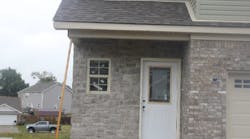The Kentucky Fatality Assessment and Control Evaluation (FACE) Program is tasked with investigating fatalities and making recommendations to ensure they do not occur again. This is one of their recent cases.
On Friday, Aug. 25, 2017, four gutter installation specialists arrived on the construction site of a new private residence for the purpose of installing gutters. This was their first day on the site. At approximately 11:00 a.m., the victim and a co-worker gathered two, 16 ft. aluminum extension ladders and approached the front porch.
The workers set up the first ladder on the side of the house in order to access the porch roof. The two then worked together to carry the second ladder up to the porch roof, where they positioned it in order to take measurements of the house roof. The victim ascended the second ladder while his coworker held the base of it in order to keep it in place.
The victim took measurements and verbally communicated the results to the owner of the company who was located on the ground below.
In an interview with the coworker who was holding the ladder, he stated that as the victim completed his measurements and began descending the ladder that was placed on the porch roof, the steep angle of the porch roof caused the base of the ladder to ‘kick out’ and strike the employee who was holding the ladder. This resulted in the victim, the coworker and ladder all falling 10 ft. 9 in. from the porch roof to the ground below.
As the incident occurred, the owner of the company stated that he had his back turned away from the house and was walking away in order to cut the guttering material when he heard the noise behind him. As he turned, he observed the two employees and the ladder on the ground.
The coworker was uninjured, but the victim had landed on his head and neck area, and was unresponsive. The owner of the company rushed to the victim and called 911. Emergency services arrived within five minutes of the call and transported the victim to a local hospital where he was pronounced dead at 3:13 p.m. the same day.
Cause of Death
The cause of death was blunt force head and torso injuries due to a fall from height.
Contributing Factors
Occupational injuries and fatalities are often the result of one or more contributing factors or key events in a larger sequence of events that ultimately result in the injury or fatality. Investigation identified the following unrecognized hazards as key contributing factors in this incident:
- Lack of hazard recognition and safety training
- Performing work at heights without adequate fall protection
- Ladder not used on stable and level surface
Recommendations
Perform a job hazard analysis of the worksite.
A job hazard analysis (JHA) is a technique employed by site supervisors, experienced employees, and safety personnel that focuses on job tasks as a way of identifying potential hazards that workers may encounter when performing each task. Had a job hazard analysis been performed, it is likely the employer would have recognized potential hazards on the site, which included working at heights above six feet and using a ladder on an uneven surface.
Train employees on and enforce the use of fall protection when working at heights above 6 ft.
The victim and a coworker were on the roof of the porch, 10 ft. 9 in. above the ground. In interviews with other employees, they acknowledged that the owner of the company had never directed them to wear fall protection nor were they ever trained on how to inspect or adjust a personal fall arrest system (PFAS). Failure to protect employees while working at heights and failure to properly train and document completion of fall protection training directly violates two separate OSHA standards.
Ensure ladders are placed on sturdy, level ground or secured before use.
At the time of the incident, the victim was descending a ladder whose base was being held in place by a coworker. The base of the ladder was positioned on the roof of the porch that had a measured pitch of 6:12. A roof’s pitch is measured by how many inches the roof rises for every 12 in. it moves inwards toward the peak (or ridge). A roof with a pitch of 6:12 would convert to an angle of 26.5o. If there was no feasible way to secure the top of the ladder to the house roof, efforts should have been made to secure the base of the ladder to the porch roof.
Implement workplace health and safety programs.
NIOSH encourages employers concerned about opioid use among their workforce to implement health and safety policies and programs to support employees, as well as to create and maintain healthy workplace environments. The form of a workplace health and safety plan or program will vary depending on the work setting and many other considerations. Increasing numbers of states are developing programs to educate and guide employers through steps they can take to address the opioid crisis among workers and help create healthier and more productive workplaces. If workplaces include drug testing as part of such programs, the testing should be performed as part of an overall plan or program intended to assist workers who struggle with drug use, especially opioid use6. Allowing workers confidential access to medication-assisted treatment (MAT) should be an important part of such workplace programs.
Mention of any company or product does not constitute endorsement by the National Institute for Occupational Safety and Health (NIOSH). In addition, citations to websites external to NIOSH do not constitute NIOSH endorsement of the sponsoring organizations or their programs or products. Furthermore, NIOSH is not responsible for the content of these websites. All web addresses referenced in this document were accessible as of the publication date.
